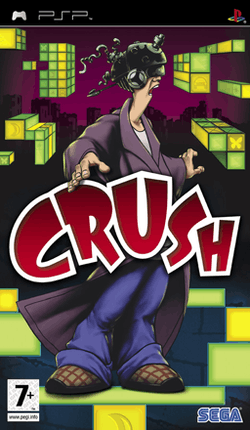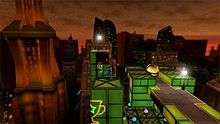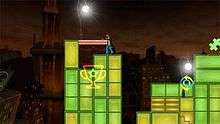Crush (video game)
| Crush | |
|---|---|
 | |
| Developer(s) | Zoë Mode |
| Publisher(s) | Sega |
| Platform(s) |
PlayStation Portable Nintendo 3DS[1] |
| Release date(s) |
PSP
‹See Tfd› Nintendo 3DS |
| Genre(s) | Puzzle/platformer |
| Mode(s) | Single-player |
Crush is a platformer-puzzle video game developed by Kuju Entertainment's Zoë Mode studio and published by Sega in 2007 for the PlayStation Portable. Its protagonist is Danny, a young man suffering from insomnia, who uses an experimental device to explore his mind and discover the cause of his sleeplessness. Each level of the game, representing events from Danny's life and inspired by artists such as Tim Burton and M.C. Escher, requires the player to control Danny as he collects his "lost marbles" and other thoughts.
Crush's primary gameplay feature involves manipulating each game level between 3D and 2D views, allowing the player to reach platforms and locations inaccessible from within a different view. This element was noted by critics to be similar to one in Super Paper Mario, also released in 2007, though the Zoë Mode team had envisioned the concept five years prior. Crush received positive reviews upon release, with critics praising its incorporation of this dimension-shifting component alongside other aspects of the game presentation. Though Crush won several gaming awards, including PSP game of the month, it failed to meet the developer's sales expectations. A port of the game for the Nintendo 3DS called Crush 3D was announced on January 19, 2011 and was made available on January 13, 2012 in Europe and on March 6, 2012 in North America.
Plot
While Crush and its Nintendo 3DS port Crush 3D retain the same gameplay mechanics and premise, the two versions feature different plots.
PSP version
The protagonist of the game, a young man named Danny Roman, suffers from chronic insomnia caused by worry, stress, and repressed memories. He is admitted to a mental institution for it, where he consults a mad scientist, Dr. Reubens, who treats Danny with his Cognitive Regression Utilizing pSychiatric Heuristics (C.R.U.S.H.) device, which has a sentient female persona.[3] The device's helmet places Danny under hypnosis, during which he can regain control of his sanity by collecting his lost marbles, and facing his primal fears in the form of monsters (i.e. cockroaches, blockwalkers, slugs). Danny starts spilling the beans to Reubens about his city life; moving into his first apartment and his suffering job as a chef. He depends on Reubens for some serious help if he wants to get a good night's sleep. Later, when C.R.U.S.H. projects the image of a bucket and shovel at the beach onto the helmet, he recalls his love life some few years ago with a girl named Tina (who Reubens mistakenly thought was Danny's mother, a recurring joke). Returning the next summer, Danny is jilted for a more handsome man. Devastated, Danny ends up sitting on the pier in shame, accidentally falling into the ocean below, but eventually rescued. Reubens explains that the rejection causes him to distance himself from women, and tells him to get some rest. The next day, while Dr. Reubens tunes up his machine, making questionable noises, Danny recommends he give them some time alone, but the word "alone" has Reubens lead Danny to recollect the time he was assaulted as a young boy at a local funfair by three thugs, however, Danny blames himself, not his parents, for his mistake, as he ditched his parents to go to the funfair alone, but they find and rescue him (again). He then promised his parents that he'd "stay with them forever." Dr. Reubens uses this evidence to come to a conclusion that homesickness is the cause of his insomnia, recommending that Danny moves back into his parents' house, but his conclusion is proved wrong when Danny returns one more time. Dr. Reubens snaps at Danny for wearing out his machine further, and questions if he is merely "toying" with them. Pushing the limit, Reubens regresses Danny all the way to his childhood, when he was only six years old, against Danny's own will. Danny cries, begging that Reubens stop "unlocking doors that should stay bolted," but in the end, he reveals that his parents went out on a date and left him at his house alone, with disturbing shadows of the night leaving Danny in psychological trauma. Danny discovers that his childhood fears at that time, principally being afraid of the dark, are the real cause his insomnia, sending him "spiraling back into [his] six-year-old self." Reubens is full of disgust that his treatment was a complete waste and that Danny ruined his machine due to his nyctophobia, but tells Danny he's cured. Right when Reubens begins to snap Danny out of hypnosis, C.R.U.S.H. goes over the edge and seems to attack Danny's mind, with Reubens panicking and Danny's life on the line while the screen fades to black at the start of the attempt.[4]
3DS version
Doctor 'Doc' Doccerson (instead of Reubens in the PSP version), is infuriated that all of his inventions failed, but today he 'shall surpass them all' with his latest invention, C.R.U.S.H. He uses a tape recorder for his scientific narrative on the experiment. With the help of his best friend and protégé, Danny (a running gag consists of him correcting Doc throughout the game), he enters his mind as his subject to C.R.U.S.H., but after a few tests, Danny is trapped inside C.R.U.S.H., where he can collect his lost marbles (which will unlock new dressing gowns/robe designs) and facing his fears in the form of monsters (i.e. cockroaches, slugs). At one point, Doc tells Danny that C.R.U.S.H. will not let Danny out due to "unresolved feelings." The two question that reasoning as they progress. Towards the end, C.R.U.S.H. interrupts contact between Danny and Doc, overly infatuated with Danny. Danny slowly admits to C.R.U.S.H. that she is simply a machine and compares it to "flirting with a parking meter." C.R.U.S.H., infuriated, sends Danny back to his childhood as a result. When Doc comes back into contact with Danny, Danny lashes out at Doc for building a machine "with the heart of a teenage girl" who "LOLd" at him. Doc, calming Danny down, explains how this "subconscious" is not really his, but old data, and suddenly Danny becomes shocked when he realizes he took the place of someone who underwent treatment with C.R.U.S.H. (being the PSP Danny), but "she knows [he's] not the same." C.R.U.S.H. really wanted Danny to clear her head. In the ending, Danny finally escapes and is free out of C.R.U.S.H's mind. He and Doc discuss C.R.U.S.H's future, while Doc says that he'll fix her. In a sudden plot twist, it turns out that they were not in the real world at all, but all the levels throughout the game are outside Doc's lab. C.R.U.S.H. smiles and laughs into the camera, she winks and the screen cuts to black.
Gameplay


Crush contains ten levels in each of the four locations, all based on an event in Danny's past.[5][6] The levels represent Danny's mind: a dark city landscape with many tall buildings and the occasional street lamp, a hotel resting aside a seaside location, a dark and mysterious funfair, and a haunted childhood bedroom. Levels are mostly composed of platforms formed by blocks. The player's goal in each level is to collect marbles, which give the player points based on their color. The exit from the level is opened once a predetermined number of points have been collected. Danny can crawl into narrow areas and jump a small height.
The main gameplay feature of Crush is the ability to transpose the layout of a level between 2D and 3D representations to reach seemingly inaccessible areas and solve the game's puzzles. The player can switch the third-person camera between four directional side views and a top-down view at any time while in 3D. When in these views, the player can have Danny "crush" the level, collapsing all 3D elements into 2D; crushing from side views results in a 2D platformer-like view, while crushing from the top-down view provides a 2D top-down perspective. Crushing can connect and merge platforms on the same visual plane in the 3D view but separated by a large distance, creating pathways across the level in the 2D view. The player can also "uncrush" the level at any time. Certain blocks, when crushed, become either obstacles through which Danny cannot pass, or ledges the player can use to reach other parts of the level. Attempts to crush a level in any manner that would harm Danny are thwarted. However, uncrushing can leave Danny in a helpless state, such as hanging in mid-air.[7]
Enemy monsters inhabit the levels, but the player can crush them by flattening impassable blocks against them. The player may also encounter timers in the form of alarm clocks that will begin to elapse when crushed for the first time and can only be stopped when Danny jumps on them. Danny wakes from his mental explorations if he falls off the level or too high of a surface, is touched by a monster, or fails to stop a timer, but the C.R.U.S.H. device reinserts him at the start of the level or the last checkpoint Danny passed.[4]
Throughout the levels are scattered large spheres and cylinders, which the player can roll when crushed appropriately. These can then be used as platforms or to depress switches. Jigsaw pieces can be collected to reveal concept art and extras in the game's menus. Some of Danny's "thoughts", represented by glowing neon icons on the walls of the level, are only activated when the level is crushed in a manner that does not obscure them.[7] Some thoughts allow Danny to jump higher or stop time. Once the player completes each level, they are graded by the duration of Danny's stay on the level, how many times Danny "woke up", and a bonus for collecting all marbles, the jigsaw piece, and a hidden thought trophy.[7] The thought trophy, once completed by crushing, unlocks a level's special challenge mode for later play which requires time-limited completion of the level with an allotted number of crushes.[5]
Development
In an interview, Zoë Mode executive producer Paul Mottram claimed that the game concept was envisioned in 2002, but work did not actually begin until 2006. The initial concept was built on the crushing mechanism between 2D and 3D, and they only had to create appropriate obstacles to prevent players from simply "crushing" across the level.[8] Mottram noted that during the development of Crush, the gameplay of Super Paper Mario had not yet been revealed, and thus the team was surprised to learn that it shared a similar feature.[9]
Mottram stated that the crushing mechanism had been developed and refined for six months before developing the story and characters; the development team wanted to have "a normal person in an impossible situation".[9] The art and level design were inspired by Tim Burton, Mike Mignola, and M.C. Escher. The plot was originally more morbid than in the final product, with Danny dying and the rest of the game told as flashbacks.[9]
The game levels were developed on a level editor on the PlayStation Portable, but Zoë Mode were not able to refine the editor in time for shipping. Mottram said "It would be great to see user generated content and this is something we have been seriously thinking about for the future" and that downloadable content "would work perfectly with the Crush level structure and I am sure that fans of the game would be eager to see more levels."[9] Mottram has stated they would like to market a sequel based on the highly positive feedback they had received;[8] however, with other Zoë Mode projects such as SingStar and Play taking precedence, he does not know when this could be.[10]
Reception
| Crush | ||||||||||||||||
|---|---|---|---|---|---|---|---|---|---|---|---|---|---|---|---|---|
| ||||||||||||||||
Crush received generally positive reviews, with aggregate scores of 83 out of 100 from Metacritic[13] and 82% from GameRankings.[11] The game was highly praised for its innovative approach to gameplay. Ryan Davis of GameSpot appreciated Crush for owing "very little of its novel concept to games that preceded it".[4] Nick Suttner of 1UP called the game a "cognitively rewarding, expertly designed puzzle experience that truly plays like nothing else".[16] Reviews were mixed on the game's learning curve. IGN's Jeremy Dunham praised the ordering of the puzzle elements, that new gaming elements are introduced at "an ideal pace", and that most puzzles have solutions where the player must "think 'outside the box'".[5] Eurogamer's Dan Whitehead commented that the game introduces these elements too quickly and "doesn't give you much time to put the basics into practice".[7] Some critics found that elements of the game detracted from the game's uniqueness. X-Play's Greg Orlando, while stating that this was "one of the most novel games ever made", noted that it was "simply not very fun", as it lacked many player incentives beyond manipulating the world and collecting objects on each level.[17] Reviewers noted that some puzzles were awkward due to the selection of the PlayStation Portable's controls.[5][16] Reviewers found the game's story poor, but this was overcome by the gameplay elements; Charles Harold of the New York Times said "the minimal story is as forgettable as its puzzles are ingenious".[18] GamesRadar included it in their list of the 100 most overlooked games of its generation. Editor Jason Fanelli stated that the ability to switch from 2D to 3D was "one of the most unique (at the time) features we’ve ever seen."[19]
IGN awarded Crush PSP Game of the Month for May 2007.[20] GameSpy called Crush the third best PlayStation Portable game and the "PSP Puzzle Game of the Year" for its Game of the Year 2007 awards.[21] Similarly, IGN awarded Crush the "Best PSP Puzzle Game", "Most Innovative PSP Game", and "Best PSP Game No One Played" awards in their Game of the Year 2007 selections.[22] Crush won the 2007 Develop Conference Industry Award for "Best New Handheld IP".[23] According to Paul Mottram, positive reception of the game did not translate into high sales, but the game "will hopefully stick around for a while and continue to shift units".[10]
See also
References
- ↑ Caolai, Eric (2011-01-19). "Sega Porting Crush To 3DS". Game Set Watch. Retrieved 2011-01-19.
- ↑ "Crush 3D". Retrieved September 8, 2011.
- ↑ Zoe Mode (2007). Crush Instruction Manual. Sega of America. p. 4. ULUS-10238.
- 1 2 3 Davis, Ryan (2007-06-05). "Crush Review". GameSpot. Retrieved 2008-10-02.
- 1 2 3 4 5 Dunham, Jeremy (2007-05-31). "Crush Review". IGN. Retrieved 2007-07-26.
- ↑ Keller, Matt (2007-06-11). "Crush Review". PALGN. Retrieved 2009-09-08.
- 1 2 3 4 5 Whitehead, Dan (2007-05-24). "Crush". Eurogamer. Retrieved 2008-10-02.
- 1 2 "Interview: Paul Mottram, Zoë Mode senior producer". Sega Nerds. 2007-06-11. Archived from the original on 2007-07-16. Retrieved 2007-08-14.
- 1 2 3 4 Modojo Staff (2007-07-09). "Interview: Crush Executive Producer Paul Mottram". MoDojo. Retrieved 2007-08-14.
- 1 2 Wallis, Alistair (2007-08-26). "Media Consumption: Zoe Mode's Paul Mottram". Gamasutra. Retrieved 2008-10-02.
- 1 2 "Crush Reviews". GameRankings. Retrieved 2007-07-26.
- ↑ "Crush3D". Game Rankings. Retrieved 2015-05-15.
- 1 2 "Crush". Metacritic. Retrieved 2007-07-26.
- ↑ "Crush3D". Metacritic. Retrieved 2015-05-15.
- ↑ Phillips, Tom (2012-01-13). "Crush3D Review". Eurogamer. Retrieved 2015-05-15.
- 1 2 Suttner, Nick (2007-05-29). "Reviews: Crush". 1UP. Retrieved 2007-07-26.
- ↑ Orlando, Greg (August 2007). "Crush". G4TV. Retrieved 2008-10-02.
- ↑ Harold, Charles (2007-06-16). "What if You Met the Enemy and It Really Was You, and Then It Happened Again". The New York Times. Retrieved 2008-10-02.
- ↑ Fanelli, Jason (2013-12-20). "The 100 most overlooked games of the generation". GamesRadar. Retrieved 2013-12-20.
- ↑ IGN PlayStation Team (2007-05-31). "PSP Game of the Month: May 2007". IGN. Retrieved 2007-08-14.
- ↑ GameSpy Staff (December 2007). "GameSpy's Game of the Year 2007 - PSP Top 10". GameSpy. Retrieved 2007-12-22.
- ↑ IGN Staff (December 2007). "IGN Best of 2007 - PSP". IGN. Retrieved 2007-12-22.
- ↑ Boyer, Brandon (2007-07-26). "2007 Develop Industry Award Winners Announced". Gamasutra. Retrieved 2007-07-26.
External links